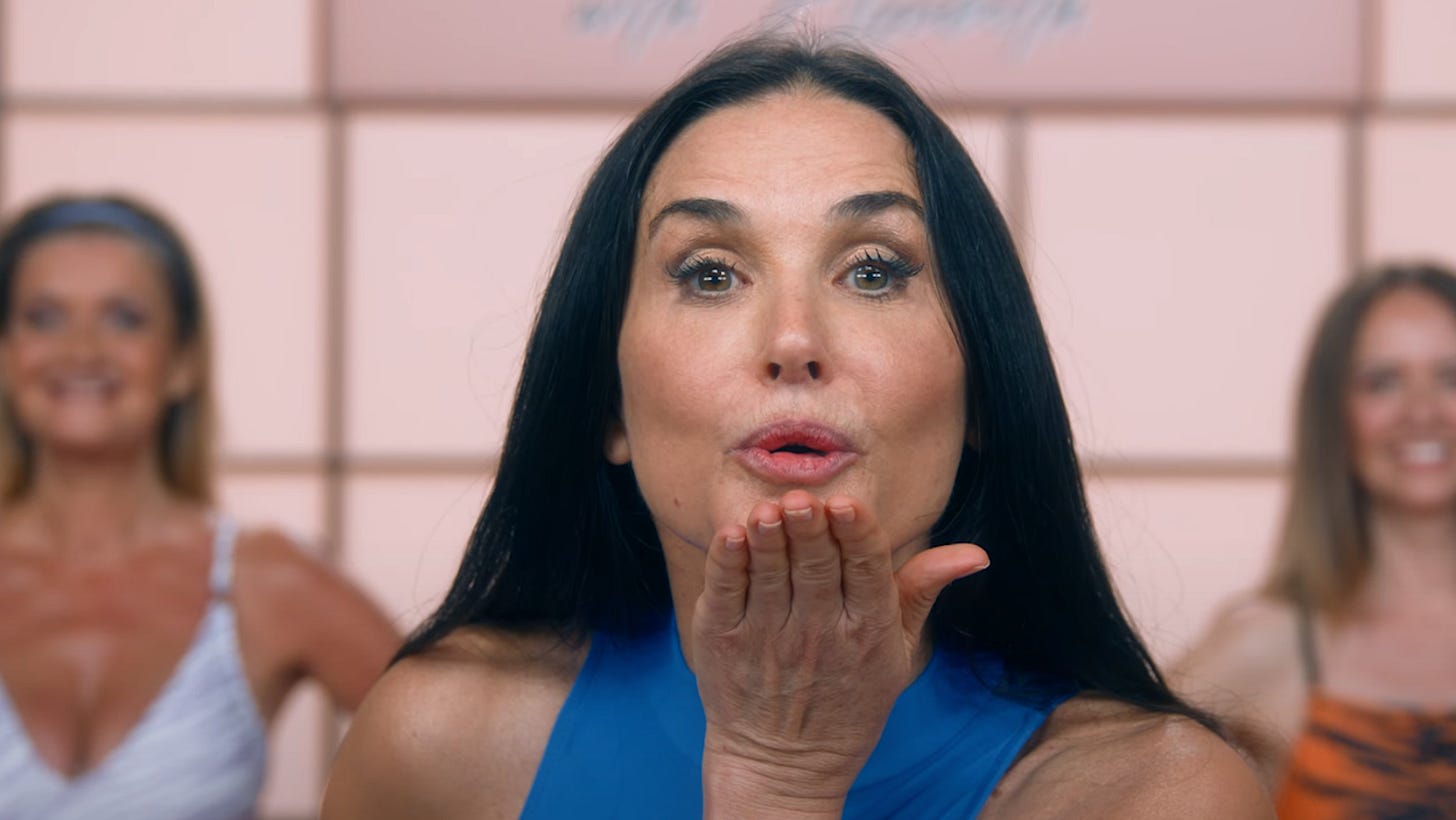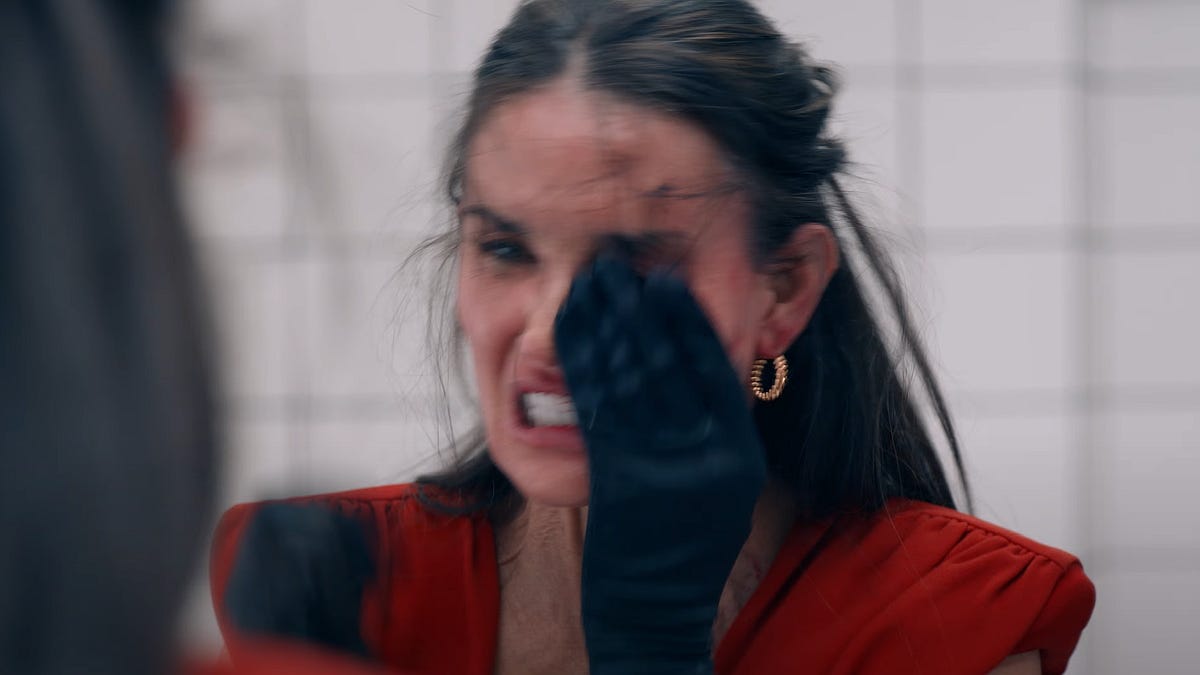'The Substance' made me cry
Spoilers abound, if you care about that. No weekly viewing diary this week; I will do a double 'How I'm Living Now' post next week.
I don’t think I’ve ever seen a Demi Moore star vehicle in full,1 save for The Scarlet Letter which we watched in high school English, but I was a child in the 1990s with basic cable so I’ve seen various scenes from more or less every one of those films.
I was 14 when Charlie’s Angels: Full Throttle came out, which I believe I saw with my sister and a friend or two of hers on a long, boring summer afternoon. I didn’t really care for the movie, but I remember having a visceral response to the introduction of Demi Moore as “Madison Lee,” the rogue Angel from the previous generation or whatever about halfway through the movie; I was like, thank God; finally, here is some glamour and talent.
Despite never having an obsessive moment with her work, which is something I’m prone to when I “get into” an actor or director, I’ve always considered her one of “my guys.”2 I have always rooted for Demi Moore.
The second shot of The Substance is an overhead shot of Demi Moore’s character Elisabeth Sparkle’s star on the Hollywood Walk of Fame being constructed; a time lapse ensued over The Star, being adored by fans and eventually cracking and fading with the relentless onslaught of time.
I can’t explain it, but I knew in this moment that I was in good hands; I was immediately reminded of the opening Q&A sequence of Tár, in which the moderator reads Lydia Tár’s list of career accomplishments, saying that she’s in the rarefied group of EGOT winners.
These are subtle moments early in each of these films that signal an ugliness in celebrity culture, that highlight the stupidity and superficiality of status. I am a person who constantly thinks about awards in art (I’m gay) and having that concept depicted at me in a prestige film is a slap in the face: really, who gives a fuck if Lydia Tár is an EGOT winner? if Elisabeth Sparkle has a star on the Hollywood Walk of Fame? Why should anyone care about that?
The Substance, the second feature film from French filmmaker Coralie Fargeat, tells the story of Elisabeth Sparkle, who is let go from her hit primetime network television aerobics class show (which is absurdly funny, conceptually). On her way home from her firing, she watches as her face is torn from a billboard and unceremoniously discarded. Yesterday’s news. She is then hit by a truck, which she miraculously survives without a single broken bone, much to Elisabeth’s profound sadness.
A young nurse gives Elisabeth a USB drive and a phone number which will teach her about the titular substance. Using this substance, she can create a younger, better version of herself, which of course she elects to do, because that is the movie we are watching. She stands in her bathroom stark naked and the camera lingers on her aging body, both a fact of life and an utter horror to a woman so consumed with appearances.
The birth of Sue (Margaret Qualley), the new Elisabeth, is horrifying and exciting. It is the birth of Frankenstein’s monster,3 something so novel and mysterious that one would never dream of stopping it from coming to fruition, because one simply has to know.
The deal is this: Elisbaeth must alternate one week in her new body and one week in her original body, or else there will be great consequences. Fascinatingly, Elisabeth cannot remember what happens during the Sue weeks, and vice versa. Elisabeth was desperate to be younger, more beautiful, but that’s not what happens. She does not get to enjoy Sue’s spoils. Sue is her own person, made from Elisabeth’s raw material. And Sue is not afraid to exploit her position as the young one, the perfect one. She has no empathy for her older, original self. She starts stealing time from Elisabeth, which has compounding ramifications for them both.
The Substance is a remarkable motion picture. Its visual strategies are influenced by Stanley Kubrick by way of Roger Corman and its performance strategies are straight out of Jerry Lewis: the film is ugly and garish and brash and cheap and uneven and cartoonish, all in service of its core truth. We have all been Sue and we will all, eventually, be Elisabeth Sparkle.
The film has a persistent undercurrent of dread, the kind of dread that steals from your life the same way that Sue steals from Elisabeth’s life. During the Elisabeth weeks, she ends up sitting in front of the TV eating; she ultimately cannot handle the fact that there is a younger, more beautiful version of herself out there, who is in fact not her. All the substance has done is make her share half of what time she has left with the embodiment of her insecurities.
Not every over-the-top, hyperdirect choice the film makes works. There is one moment in particulary that made me roll my eyes. But I found its imperfections to be part of its charm, as I do when I watch a Corman or a Lewis. The imperfect execution creates a great aesthetic distance which gives the audience permission to laugh at The Substance as much as laugh with it.
There is an instinctual urge to reject the core of The Substance, to say, I do not see myself in the film. But no one is above these superficial concerns, which are the stuff of everyday life in the social media era. Young women are posting makeup tutorials and young men are posting workout routines at younger and younger ages. There is a fifty year old billionaire who injects his son’s blood and thinks he will be able to cure death.
Toward the end of the film, Elisabeth is given the option to terminate Sue and return to her life. She almost does it, but in the end, she can’t. Even if she does not get to personally experience what Sue does, she still cannot let go of the fantasy that Sue is out there, living the dream that she thinks she deserves, while being a perfect physical specimen. Ultimately, there is no way out from these insecurities. There is only the relentlessness of obsession with youth and physical appearance, and it will kill us all.
Moore plays this scene with such a depth of emotion that it took my breath away and brought tears to my eyes. Her pain may be about something superficial, but her pain is real nonetheless. She is a fitness instructor; she has spent the entirety of her adult life thinking about her health and appearance in one way or another. Your body is your life’s work, and every choice you make becomes reflected on your body and in your longevity.
Five minutes later, Sue bashes Elisabeth’s head into the sink over and over until she is near-dead, forgetting that she needs the body in order to survive. There is a Verhoevean intensity to this moment, its attention to the viscera, and in its relentlessness,4 an anger so white-hot that this is the only way it can be honestly expressed.
At the very end of the film, Elisabeth Sparkle is a blob entity after having become a literal monster creature due to the compounding effects of multiple slight misuses of the substance.5 As the blob crawls to its final resting place, her own star on the Hollywood Walk of Fame, there is a superimposition of Demi Moore’s face: her hair is pulled back, she is maybe naked, maybe without makeup. She is beautiful and hopeful, smiling. Pure. I was reminded of the ending of Mulholland Drive, where we see Naomi Watts’ own hopeful innocence as we saw her at the beginning of the film, bringing to bear the profound loneliness of not just Hollywood but all human existence and the choices we make to survive.
I see myself in Elisabeth Sparkle and I see myself in Sue. I have obsessed over my body, I have found food disgusting and horrifying, I have cancelled social engagements because I simply couldn’t leave the house, I have been cruel when I was afforded beauty and cruel when it was taken away. I have utterly destroyed my body and my mind for the sake of perfection. And if that doesn’t resonate with you, you are welcome to consider yourself lucky.
I’ve seen plenty of her supporting and ensemble work, though.
The obsessive moment is happening now, in fact. I watched Ghost last night for the first time and found its artistic merit to be greater than expected and its racism to also be greater than expected.
By which I mean specifically, in this case, the James Whale interpretation of the event.
I keep using this word, relentless but if I had to describe the film in a single word, that’s it, felt in every frame of its 2 hours 20 minute runtime.
I’m not going to get into the creature feature aspect of the third act, because you just have to witness it.








I liked that the aesthetics of The Substance were GTA V.
"finally some glamour and talent" is what i said when this hit my inbox